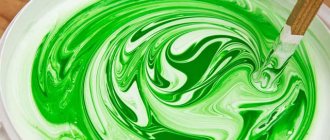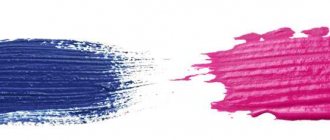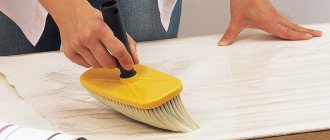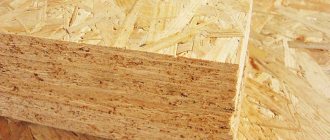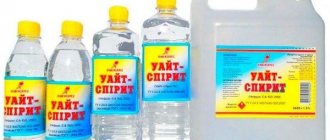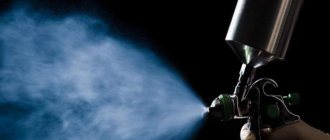Types, composition and properties
To understand how to remove paint from fabric or other surfaces, such as carpeting, at home, you need to know as much as possible about gouache:
- It dissolves well in water, just like watercolor.
- It has a thick, dense structure.
- Bright, rich color of various shades, which are achieved due to the special composition of this substance.
- Once applied to the surface, it fades slightly, allowing artists to achieve a matte, natural look to a particular painting.
- To avoid cracking of the dried mass and quickly clean it from the surface, apply gouache in a thin layer.
Gouache
Kinds:
- artistic;
- fluorescent;
- poster
Gouache composition:
- Its main components are glue and white. Due to the presence of glue, the substance becomes thick, adheres perfectly to the selected base and dries quickly. Whitewash imparts a matte finish and also brings a certain thickness.
- Additional components include: binders (phenols, water, alizarin oil, gum arabic), as well as plasticizers (gum, dextrin, glycerin and others).
- In addition, it contains synthetic mixtures that affect pigments. They make gouache unusually bright.
- It is water-based, but it will not be possible to remove it from things or other surfaces with ordinary liquid.
To remove stains most effectively, before starting this procedure, study what solvents are included in a particular paint and use them during washing.
Wash by hand
However, we should not forget about the many folk methods for removing the substance in question from T-shirts, shirts and other materials. The main thing is to follow certain recommendations and tips that will help you achieve maximum results.
Prevention of drying out
Masters do not advise mixing shades inside a container - for this there is a special device called a palette. If it is not available, any smooth surface (plate, board, small tray, etc.) will do. Before starting work, each color is thoroughly mixed in its own jar, then some is transferred to the palette.
The gouache is not diluted too much; the consistency should resemble thick sour cream. Painting from jars is not recommended - in an open container the pigment dries faster and the paint can mix with other colors. It is important to collect containers after work, close each jar tightly, and check it.
Jars should not be placed in places where the temperature may be low (below zero). It is sufficient to store at room temperature. You can even use very old kits, including Soviet ones. The main thing is to constantly check the condition of the pigment, add a little water (preferably distilled) if necessary, and mix thoroughly until smooth.
Attention! Acrylic gouache cannot be diluted using these methods. The pigment has a special composition, which water will turn into a hard mass unsuitable for painting.
Thinning paint is not suitable for professional artists. Despite the simplicity of the technique, the pigment is diluted and slightly loses color saturation and other properties. These methods are suitable for amateur drawing or creativity with children.
Source
How to wash gouache from various surfaces
In the process of removing gouache stains, it is necessary to take into account what kind of surface we are talking about. Hard materials can be treated with very aggressive substances, but it is better to wash clothes and furniture covers using gentle products; they will not harm clothes and other textile materials.
- Features of bolognese fabric: properties and characteristics of the material
We recommend reading: How to remove brilliant green from linoleum
How to remove gouache from clothes
Most often, during the painting process, gouache ends up on clothing and leaves very noticeable stains that are reluctant to wash off. There are several proven methods to remove gouache stains from fabrics and remove stubborn stains from clothes:
- Laundry soap. Immediately after the stain appears, clothing should be removed and soaked in cold water for several minutes. After this, the dirty area is generously soaped with natural laundry soap and left for 20 minutes so that the soap penetrates deeper into the fibers of the fabric and dissolves the dye. Then the soap and dirt are washed off with cool water, and if the stain does not come off completely, the procedure is repeated.
- Oxalic acid and ammonia. Fresh contamination can be easily removed with a mixture of ammonia and oxalic acid. Both ingredients are mixed in equal proportions, the clothes are soaked in cold water, and then treated with the prepared cleaning agent. The clothes are left for half an hour, after which the acid and ammonia are washed off in cool water. To wash gouache from a white shirt or colored items, you will finally need to load the clothes into an automatic washing machine with powder.
Petrol. Old, ingrained gouache is unlikely to succumb to laundry soap or ammonia. To wash gouache from clothes, in such cases you can use purified gasoline. A cotton pad is dipped into the chemical, the dried stain is thoroughly blotted with it, and then the fabric of the clothing is rubbed for several minutes, directing movements from the edges of the stain to its center. Then the gasoline is washed off, the clothes are washed again in a solution of laundry soap, and at the final stage they are sent to the washing machine. The only drawback of this method is that it cannot be used for artificial fabrics; synthetics will deteriorate from such treatment. Attention! Before removing gouache stains from fabric, aggressive household products should be tested on a small area of fabric in an inconspicuous place. Household solvents, acids and alkalis can negatively affect the color of clothing and leave unsightly stains.
How to remove gouache from carpet
Gouache often gets on the carpet pile, and in this case it is more difficult to remove paint than from clothes; the carpet cannot be washed entirely and is subjected to intense mechanical stress. However, there are still ways to restore carpet cleanliness:
- You should try to wash off fresh gouache on the carpet with cold water. First, the top layer of paint is removed by hand, blotting the gouache with a sponge or rag. After this, the carpet is lifted, a basin or wide bowl is placed exactly under the stain and the stain is carefully poured with cold water. You need to wait until the carpet is wet through. After treating a fresh stain with water, it will become much weaker, or even be completely washed out of the pile.
- If you can’t wash the stain with water, you can use regular laundry soap. The stain soaked in water is rubbed with a bar, left for 10 minutes, and then the pile is treated with a brush, trying to completely remove the dirt. After this, the carpet is again treated with cold water to remove any remaining gouache and soap.
- If laundry soap has no effect, you can use more aggressive agents, as in the case of clothes. Gasoline in combination with table vinegar gives a good effect - purified gasoline and slightly heated vinegar are combined, mixed and soaked in this solution on a stubborn stain for 15 minutes. After this, the carpet is washed very thoroughly with cold water to eliminate the pungent odor. Vinegar and gasoline help remove even very stubborn and long-dried stains and remove gouache from the carpet.
Specialized chemicals for carpets and special stain removers have a good effect in the fight against gouache on the carpet. The substances are diluted according to the instructions or simply applied to the spot, and after 15-20 minutes, washed off with water. Carpet cleaning products are designed to remove the most difficult stains, and there are usually no problems in removing gouache from the carpet.
How to remove gouache from plastic
Due to its hard structure, plastic absorbs dirt much worse than clothing or other textiles. It is very easy to remove fresh paint from a plastic surface; just wipe the stain with a damp sponge or rag so that not even a trace remains of it.
However, if a gouache stain is not noticed immediately, it can even be absorbed into a plastic window frame, into a table surface, or into a bathtub cover. Then it will be more difficult to wash it, you will have to use rather aggressive means:
- The universal solvent White Spirit works well for removing gouache from plastic. Dip a small cotton swab in the chemical and vigorously rub the stain until it disappears completely. After this, the plastic will need to be washed with a clean, damp sponge to remove the odor.
- Another reliable remedy for gouache is brake fluid, which can be found in the stocks of car enthusiasts. Moisten a rag or cotton pad with the product, thoroughly wipe the contaminated area, and then wash it off, the stain disappears without a trace. Considering the high toxicity of brake fluid, the surface after it must be washed very thoroughly with clean warm water; among other things, this will prevent yellowing of the plastic.
- Caustic caustic soda, which is diluted with water in equal proportions, helps remove dried paint that has become strongly absorbed into the plastic surface. The solution is applied to the contaminated area and left for several hours - after some time, the dried paint will begin to bubble and come off. You can wash it off faster if you gently rub the treated area with an old toothbrush.
Advice! When working with caustic chemicals, you can only wear rubber gloves; it is advisable to wear a face mask or respirator - toxic fumes can harm your health.
How to remove gouache from wallpaper
If gouache gets on walls covered with wallpaper, then success will largely depend on the material:
- How to paint a light bulb
